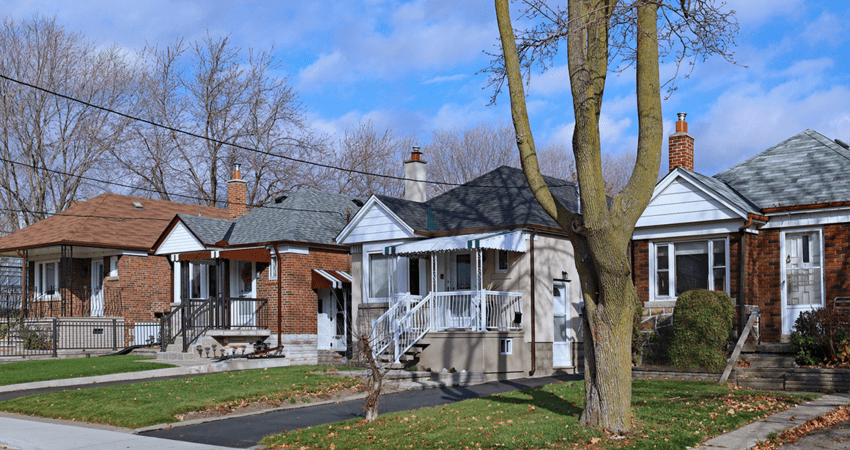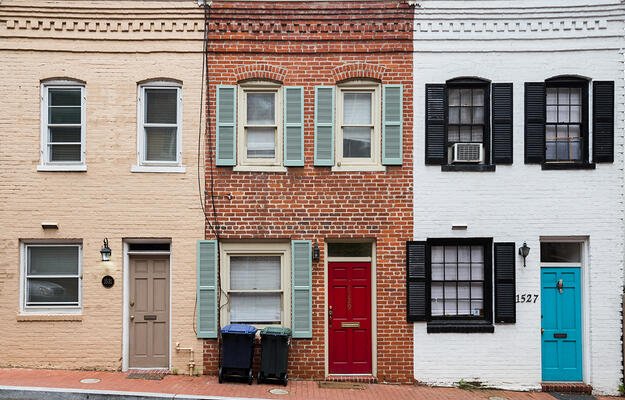
peterspiro, Getty Images
How Can the Tax Code Make Housing More Affordable?
As Congress works to address expiring provisions of the 2017 Tax Cuts and Jobs Act (TCJA), lawmakers have a prime opportunity to improve housing affordability across the country. Tax and housing policy have been long intertwined. In fact, today, more housing spending is done implicitly through the tax code (PDF) than directly through housing programs (PDF) administered by the US Department of Housing and Urban Development.
Amid the worsening national housing crisis, there are many tools federal, state, and local governments can use to improve supply and affordability. For example, the Trump administration has proposed deregulation as a solution to lower housing costs. One critical tool is the tax code, which federal policymakers should consider using to catalyze new housing production and better target federal subsidies. Here we explain how the tax code currently supports housing and how it could more efficiently deliver affordable housing across the country.
How the tax code currently supports housing
The tax code currently facilitates financing for housing development through multiple channels and provides direct benefits to homeowners.
It provides incentives that support housing supply
Financing for affordable rental housing: The Low-Income Housing Tax Credit (LIHTC) subsidizes private capital flows to finance the construction, rehabilitation, and acquisition of affordable rental housing. The federal government allocates these tax credits to states, that then award them to developers through a competitive process. The credits cover either 9 percent or 4 percent of annual qualified project expenses. Developers sell the credits to private investors in exchange for equity investment. So far, this investment has financed over 3.5 million rental housing units. These units are a key piece of the current affordable rental housing stock, particularly in rural areas and communities where private investment is more scarce.
The tax code also offers several tax exemptions intended to catalyze investor activity in the housing market. The Opportunity Zones (OZ) program, which enables investors to defer or reduce capital gains tax on their investments in designated low-income communities—which amounted to $3 billion in federal expenditure in 2024—has been largely used to finance rental housing, much of it communities already experiencing high growth. Tax-exempt multifamily bonds, issued by states and localities and authorized under federal law, have provided debt financing for nearly 1.4 million affordable housing units.
Income tax exemptions granted to the Federal Home Loan Banks—which amounted to $0.9 billion in fiscal year 2024—free up additional revenue for these entities to support affordable housing. These affordable housing investments include $752 million in contributions to their Affordable Housing Programs and $9.5 billion in outstanding loans through their Community Investment Programs in 2023.
It directly benefits and supports households
- Promoting affordable low-income homeownership: Tax-exempt mortgage revenue bonds (PDF) are another way the tax system supports families with low incomes. State and local governments sell these bonds, the proceeds from which are used to finance low-cost mortgages for lower-income first-time homebuyers. The tax code also authorizes states and localities to issue Mortgage Credit Certificates, which provide mortgage interest tax relief for low-income homeowners of up to $2,000 in mortgage interest.
Giving tax breaks to current homeowners: The home mortgage interest deduction (HMID) allows taxpayers to subtract the interest they pay on a home mortgage of up to $750,000 from their taxable income. But the HMID is only available to taxpayers who elect to itemize their deductions, and these filers tend to have higher incomes. The tax code also enables itemizers to take a state and local tax (SALT) deduction, which includes property taxes. Under the TCJA, there is a SALT deduction cap of $10,000 until 2025, and some policymakers have called for removing the SALT cap, which would increase these deductions to the benefit of the wealthiest households.
Additionally, homeowners selling their homes can exclude capital gains from the sale (up to $250,000 for single filers and $500,000 for married). Lastly, the largest but less obvious benefit to homeowners is that they do not have to pay tax on the annual rental value, or “imputed rent,” they avoid paying when occupying their own homes. This is in contrast to periodic interest or dividend payments on most other assets.
In 2024, largely wealthy homeowners received $259 billion (PDF) through these tax benefits, including $29 billion from the HMID, $59 billion from capital gains exclusion, $6 billion from the SALT deduction, and $164 billion from the exclusion for imputed rent—dwarfing all other subsidies for affordable housing production, low- and middle-income renters, or first-time homebuyers.
How the tax code could advance housing affordability right now
Lawmakers have several opportunities to address housing affordability in the upcoming tax package:
- Expand the LIHTC program to meet housing needs: Though not perfect (PDF), the LIHTC program has helped get housing built. But the available resources do not meet the demand among developers seeking financing to build. The widely supported, bipartisan Affordable Housing Credit Improvement Act would restore an increase in states’ allocations of 9 percent credits, lower the threshold for developers to qualify for 4 percent credits, and address other issues with the program. It is estimated these changes would result in financing for 2 million additional rental homes.
- Provide incentives to build and rehabilitate affordable homes for sale. Nearly 70 percent of the housing stock is single-family housing, but there is dwindling availability of affordable starter homes. There’s no program that closes financing gaps for single-family homes for sale. Congress could build off the public-private partnership model of LIHTC by allocating tax credits for the construction and rehabilitation of starter homes; the Neighborhood Homes Investment Act aims to create such a program for rehabilitation of existing units for sale to owner occupants.
- Improve targeting of OZs: Though more research is needed to fully understand the effects of OZs on overall housing supply, the program can be revisited to improve (PDF) targeting toward communities most in need. Revisions to the program can also reduce costs to the federal government.
- Reform homeownership incentives in the existing tax code. Most of the incentives to increase housing demand center around existing homeowners who tend to be wealthier, and they cost the federal government billions of dollars every year. To address this, policymakers could restructure the HMID into a first-time homebuyer credit.
- Provide opportunities for renters to benefit: Policymakers could also create a federal renter credit (PDF). This would both keep people in their homes and reduce the burden of rising housing costs on homeowners and renters. Several states and DC offer property tax credits for renters.
Ultimately, these solutions are only a piece to the larger puzzle of addressing the nation’s housing affordability crisis: a robust national housing strategy is needed to catalyze new supply and help those at the margins to afford housing. But with the prime opportunity ahead, policymakers should consider leveraging the tax code to help ensure all families can have a safe, quality, and affordable place to call home.


